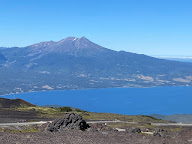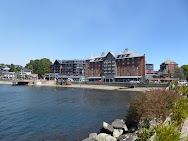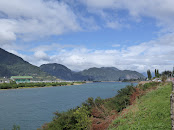Castro (Chiloe Archipelago)
There are 16 churches listed as World Heritage sites on the archipelago of Chiloe (chill-oh-way). We visited the town of Castro, with their cathedral located across from Plaza de Armas. The cathedral structure is the third building on that site, this one completed in 1771. This church was constructed by local shipbuilders, and their construction techniques are very apparent. The nave ceiling is built like a boat hull (upside down), and the support beams and joints resemble the structure of sailing ships. The entire church is wooden, and the pillars and columns holding up the church are set into large stones that are placed on large flat stone platforms. This enable the entire structure to move and flex during an earthquake, which is quite common in Chile. The three churches we visited all survived the 1960 earthquake, which was the largest ever recorded at 9.5 on the Richter scale!
 |
| Castro Cathedral |
 |
| Cathedral Nave |
 |
| Cathedral Dome |
Next we visited the Iglesia Patrimonial de Nércon church in the town of Nercon south of Castro. It employs the same construction techniques as the Castro cathedral. Sailors would hang models of their ships in the church prior to voyages to secure the blessings for a safe voyage. This church had an above-ground cemetery, which is common throughout the larger cities of Chile and Argentina.
 |
| Nercon Cathedral |
 |
| Nercon Cathedral Nave |
Finally, we visited Chonchi, which is a town with three levels leading down to the (river). The Iglesia Patrimonial Nuestra Señora del Rosario de Chonchi church is constructed similarly to the previous two churches. We then walked into the middle town to visit the Museo De Las Tradiciones Chonchinas museum, situated in an eighteenth-century house along an historically preserved street. Lastly, we walked to the lower town to walk along the waterfront.
 |
| Chonchi Cathedral |
 |
| Chonchi Cathedral interior |
Upon returning to Castro, we saw the Palafitos del barrio Gamboa, houses built on stilts to accommodate the large tidal variations. Several Chilean towns had palafitos, but only those in Castro survived the tsunami that followed the catastrophic 1960 earthquake.
 |
| Palafitos |
Puerto Montt
The towns of Puerto Montt and Puerto Varas were established
by German settlers in 1852, through a government initiative to attract settlers
to remote regions of Chile. The Germans
maintained their culture after settling these communities which is apparent in
the architecture, cuisine, Lutheran churches, names of local businesses, and
the new “German School” recently built.
Volcan Osorno (volcano) can be seen for miles, and resembles
Mount Fuji; it last erupted in 1869. As
we approached the volcano, we stopped to see cataracts (rapids) of the Rio
Petrohue in the Vicente Perez Rosales National Park (Our guide told us that
this is the first national park in Chile, and that Teddy Roosevelt played a
role in ensuring the preservation of this region). We then ascended 4000 feet to view the
snow-covered cone of the volcano, and to take in views across mountains and
Lake Llanquihue, including two other volcanoes.
The Calbuco volcano erupted in 2015, and you can see that the entire
cone was blown off by the eruption, leaving three feet of volcanic ash across
the entire region. It’s amazing to see
how the lush vegetation has grown back in the succeeding years.
 |
| Volcan Osorno |
 |
| Osorno at 4000 feet |
 |
| Volcan Calbuco |
Puerto Varas is a vacation community along the Llanquihue
lake, with great views of the two volcanoes.
The downtown area looks like an alpine village in Germany, due to the
influence of the German diaspora living in the region.
 |
| Cataracts |
 |
| Puerto Varas |
 |
| Osorno and Calbuco |




























































